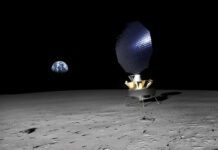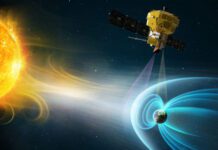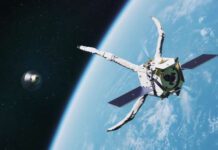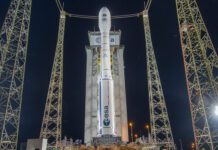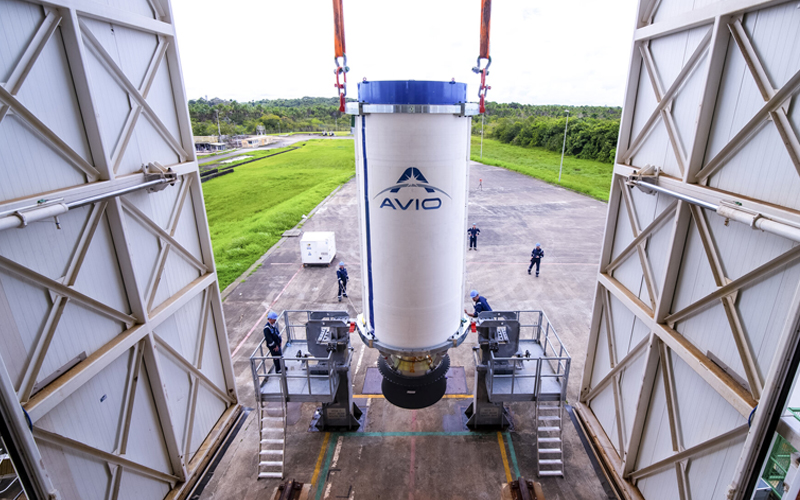
On March 3, an independent inquiry formed to investigate the cause of the 20 December failure of the first commercial flight of the Avio-built Arianespace-managed Vega C rocket shared its findings. What followed was a public relations headache for all parties involved that has continued to snowball.
The findings shared by the inquiry identified the throat insert of the Zefiro 40 second stage as the root cause of the failure. During the flight, an unexpected thermo-mechanical over-erosion of the insert caused a loss of chamber pressure and the eventual failure of the mission.
Within a solid fuel motor, like that of the Zefiro 40 second stage, hot gases are produced following ignition of the fuel grain. These gases are forced through the throat insert which creates a supersonic stream that propels the rocket forward. Any degradation of this insert thus results in a loss of thrust.
The press release
The ESA press release that revealed the identification of the Zefiro 40 throat insert as the root cause stated that the insert had been procured by Avio in Ukraine and that the investigation had led to the conclusion that “a flaw in the homogeneity of the material” was to blame for its failure. Homogeneity is, according to Merriam-Webster, “having a uniform structure or composition throughout.” The release also states that Avio was in the process of implementing an immediate alternative solution which is manufactured by ArianeGroup and which had been used for Vega’s Zefiro 23 and Zefiro 9 nozzles. And that’s more or less it.
The press release offers no detail regarding the specifications that were given to the unnamed Ukrainian company (unnamed in the press release at least) or why specifically the shift to an ArianeGroup manufactured option had been necessary. The press conference that accompanied the release of the inquiry’s findings was, however, more helpful.
There were a number of fairly large public relations mistakes made with the release of the press release. Firstly, and likely far from the most egregious, the use of words like “homogeneity” is not helpful to the general public trying to understand what you’re trying to convey and is often a red flag that the author is trying to conceal something. The second mistake was not providing more information about why exactly the throat insert failed – spoiler, it was not because the part wasn’t up to spec. Finally, it was a mistake to not give more detail about why ArianeGroup was selected to take over the supply of the material for the insert.
The press conference
The press conference was far more useful, but questions still remained following its conclusion.
Speaking at the March 3 press conference, inquiry co-chair Giovanni Colangelo explained that the carbon-carbon material used during qualification testing of the Zefiro 40 second stage and during the inaugural flight of Vega C was better quality than had been required by Avio. However, for the failed 20 December flight the material was exactly to spec, clearly placing blame at the feet of Avio and not at the door of the Ukrainian supplier Yuzhnoye.
Then we get to the issue of the change of supplier. During the press conference, Avio CEO Giulio Ranzo stated that the company had been examining alternative options even prior to the failure as a way to mitigate supply issues caused by the invasion of Ukraine. However, it was not made clear why Yuzhnoye could not continue to supply material for the throat insert with ArianeGroup utilized as a backup if supply should become an issue. This question has, from what I can see, remained unanswered.
The response
Following the release of the inquiry’s findings, the State Space Agency of Ukraine responded with a statement. The agency stated that it had only learned about the findings from the European mass media specifically referencing the ESA statement and not the press conference, which, as I have outlined, was less than ideal. The State Space Agency of Ukraine went on to explain that the ESA statement left no grounds for further discussion and cast a “shadow over the reputation of the space industry of Ukraine.”
In a letter sent on February 28 to ESA and shared by Les Echos, the French space agency CNES preempted the Ukrainian response casting doubt on the thoroughness of the independent inquiry.
“CNES considers that the investigation is not thorough enough to determine why and how such an accident took place and what made it possible, and what decisions taken by the industry and by the agency led to such a risky and uncontrolled situation.”
In response to Ukraine’s statement, on March 7 ESA Director General Josef Aschbacher responded on Twitter reiterating the agency’s support of Ukraine.
“First and foremost, ESA stands with Ukraine and the plight of its people. The conclusions that the committee found are not a means to place blame on Ukraine or on the integrity of the Ukrainian space industry, an industry that has been gaining much deserved clout in recent years.”
Arianespace CEO Stéphane Israël quote tweeted Aschbacher’s statement stating that Arianespace fully agreed with the DG’s sentiment.
“Launch is not risk free. We have only respect for the Ukrainian space sector. We stand with Ukraine,” added Israël.
Avio CEO Giulio Ranzo has not made a statement since the publishing of the statement from the State Space Agency of Ukraine. In a LinkedIn post just following the release of the inquiry’s findings, Ranzo made no reference to Ukraine, seemingly unaware of what was to come. Interestingly, in the statement, the Avio CEO thanked CNES for its support despite the agency having questioned the legitimacy of the inquiry’s findings days earlier. Ranzo also indicated that the backlog for Avio was currently more than 15 launches deep, giving a glimpse into what DG Aschbacher has, along with the delay of the maiden flight of Ariane 6, referred to as a “crisis.”
As far as I can tell, neither the Italian space agency ASI nor its president Giorgio Saccoccia has commented on the investigation. The only mention of it is a Twitter post on the official ASI account sharing the press release with no additional comments regarding the findings.
I can’t help feeling that the release of the inquiry’s findings was rushed. I’m left with so many questions about ESA’s handling of the situation. Why was Ukraine not informed prior to the release of the findings to ensure consistent messaging? Why was the press release not more explicit in describing what the inquiry had discovered? And finally, why hasn’t the agency updated the press release since its publishing almost a week ago?



